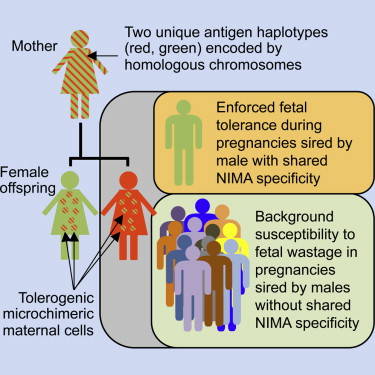NIMA and microchimeric maternal cells
Successful pregnancies require that mothers develop tolerance to paternal-derived fetal antigens. Otherwise, the developing fetuses would be recognized by the mother’s immune system as “non-self” and destroyed. Fetal survival is even less straightforward because previous research has shown that fetuses are exposed to a diverse collection of non-inherited maternal antigens (NIMA), too. NIMA are presented throughout development, and may include antigens to which the mother has been previously exposed, or antigens derived from molecules or cell surface markers expressed by other individuals. In a recent study published in Cell, a team of researchers led by Dr. Sing Sing Way at Cincinnati Children’s Hospital hypothesized that NIMAs lead to the generation of microchimeric maternal cells that persist throughout adulthood, and that these cells promote the development of immune-suppressive allogeneic regulatory T cells (Tregs). The study demonstrates that these allogeneic Tregs increase the success of second-generation pregnancies by suppressing immune reactions to other paternally-presented antigens and expands our understanding of how reproductive fitness in mammals evolved.

Transgenes and MHC haplotypes can serve as surrogate NIMAs to examine microchimerism
To confirm the persistence of NIMA tolerance in offspring, the researchers mated transgenic female mice constitutively expressing a transmembrane fusion protein consisting of ovalbumin (OVA) linked to a variant of the H2 I-Eα protein to non-transgenic males. In the progeny of this cross and through subsequent crosses with non-transgenic mice, the transgenic fusion protein became a traceable NIMA in mice that did not inherit the transgene though the identification of a subset of Foxp3+ Tregs that recognized either the I-Eα variant or OVA.
In order to test their hypothesis that microchimeric maternal cells increase the success rate of second-generational pregnancies, the researchers employed a directed breeding approach between inbred strains of mice that carried mismatched MHC haplotypes. The mice used, included:
- C57BL/6J - H-2b; CD45.2+ (000664)
- BALB/cJ - H-2d (000651)
- CBA/J - H-2k (000656)
- B6.C-H2d/bByJ - H-2d (000359)
- B6.Ak-H2k/J - H-2k (001895)
- B6.SJL-PtprcaPepcb/BoyJ - H-2b; CD45.1+ (002014)